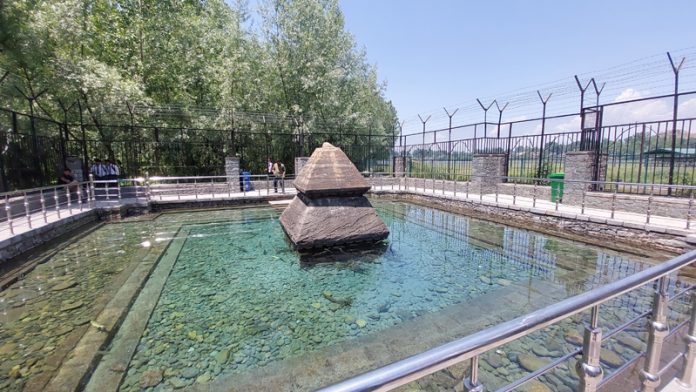Excelsior Correspondent
SRINAGAR, May 26: The local Muslims in the Manasbal area of Ganderbal district today demanded that the ancient temple-apparently related to Lord Shiva-be brought onto the tourism map ahead of the start of this year’s annual Amarnath yatra.
The people living in the area, as well as those from adjoining places, said that the temple is related to Lord Shiva and his journey to the Amarnath Cave, which attracts lakhs of pilgrims during the yatra period.
CLICK HERE TO WATCH VIDEO
“We have heard from our elders that this temple, which is partially submerged in water, is related to Lord Shiva. It is believed that when Shiva used to start his journey to Shri Amarnath Cave, this was one of the places where he would stop after Tulamulla,” said Gowhar Ahmad, a resident of Manasbal.
He said that people who worship Lord Shiva should be made aware of the ancient temple in Manasbal so that they can visit, especially pilgrims on their way to the Shri Amarnath Cave.
“Tulamulla, Amarnath Cave, and this temple are somehow related to each other and are closely linked with Shiv Ji. I want to bring this place to the notice of people across the country; they should come here and see the signs of this place being related to Shiv Ji,” he said.
It is to be noted that the temple is currently managed by the Wullar Manasbal Development Authority and is known as the submerged ancient temple. According to the authorities, the temple was built during 800-900 AD, during the reign of King Awantivarman.
The locals also pointed out a cave, known as ‘Gotra Gupha,’ on a mountain situated at a distance from the temple, stating that after visiting the temple, “it is believed Shiv Ji used to rest there in the cave.”
The official details note that the temple is constructed of local grey stone, much like the temple of Awantipora, and has engravings at the corners resembling Corinthian or floral motifs.
It is further stated that the temple remains partially submerged for the larger part of the year and is a very small structure, with only two pyramidal roofs visible during the driest seasons.
“The cornice of the lower roof and the horizontal band which divides it from the upper storey are decorated with a series of dentils and metopes,” reads a board detailing the structure.
The residents said that people from across the country have a right to visit this temple and add to the spiritual essence of the Amarnath yatra, which they undertake as part of their religious obligation.
“People should know the signs of Shiv Ji, while the government must take steps for the upgrade of the temple, making it more attractive and allowing devotees to have a different experience,” they said.
Another resident, Pervaiz Ahmad from Safapora, also said that the yatris who come for the yatra should be made aware of this temple, “because it holds great significance; perhaps, so far, people have not been told about it.”


